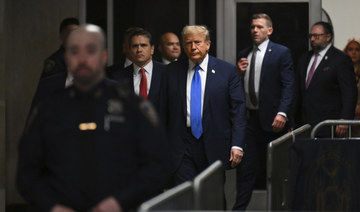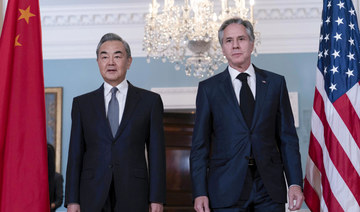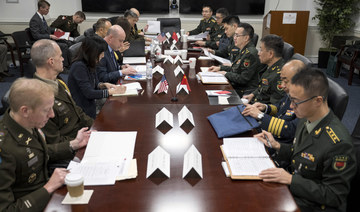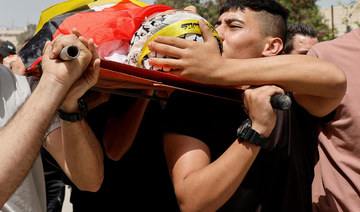TALUSTUSAN, Philippines: The American priest’s voice echoed over the phone line, his sharp Midwestern accent softened over the decades by a gentle Filipino lilt. On the other end, recording the call, was a young man battered by shame but anxious to get the priest to describe exactly what had happened in this little island village.
“I should have known better than trying to just have a life,” the priest said in the November 2018 call. “Happy days are gone. It’s all over.”
But, the young man later told the Associated Press, those days were happy only for the priest. They were years of misery for him, he said, and for the other boys who investigators say were sexually assaulted by Father Pius Hendricks.
His accusations ignited a scandal that would shake the village and reveal much about how allegations of sex crimes by priests are handled in one of the world’s most Catholic countries.
He was just 12 — a new altar boy from a family of tenant farmers anxious for the $1 or so he’d get for serving at Mass — when he says Hendricks first took him into the bathroom of Talustusan’s little rectory and sexually assaulted him.
“I asked why he was doing this to me,” the rail-thin 23-year-old said in an interview, the confusion still with him years later.
“’It’s a natural thing,’” he said the priest told him, “’It’s part of becoming an adult.’“
The abuse continued for more than three years, he says, but he told no one until a village outsider began asking questions about the American priest’s extravagant generosity with local boys, and until he feared his brother would be the next victim.
In November, he went to the police and told them what he knew.
Soon after, local authorities arrested Hendricks, 78, and charged him with child abuse. Since then, investigators say, about 20 boys and men, one as young as 7, have reported that the priest sexually abused them. Investigators say the allegations go back well over a decade — though many believe it goes back for generations, and could involve many dozens of boys — continuing until just weeks before the December arrest. Hendricks’ lawyers insist he is innocent.
The AP, which does not identify alleged victims of sexual assault, has met with five of the accusers.
Hendrick’s arrest was a sudden fall for a priest who had presided over this community for nearly four decades. He rebuilt Talustusan’s chapel and installed rooftop loudspeakers to summon parishioners to Mass. He pressed officials to pave the village road. He drove the sick to the hospital, and paid school fees for poor children. Many here will still tell you how much he did.
But the case also reflects much about the Philippines, a country where the church has long shrugged off the presence of its sex offenders and where the criminal justice system often ignores the problem.
“It’s a culture of coverup, a culture of silence, a culture of self-protection,” said the Rev. Shay Cullen, an Irish priest who has spent decades in the Philippines and works with victims of child sexual abuse. “It’s a silent consent to the abuse of children.”
In 2018, after the young man had gone to police — but before Hendricks had been arrested — he recorded a phone call with the clergyman.
In extracts of the conversation heard by the AP, Hendricks laments the passing of those happy days, and admits to an unspecified “mistake on my part.”
“Well, it’s true. I’m not saying it’s not. Did I say it’s not?” Hendricks said, his voice a combination of self-pity and resignation.
He said he’d probably have to retire.
“So I have to learn,” he continued. “I have to take the good with the bad.”
____
For nearly two decades, the Philippine church has vowed to confront a looming shadow of clergy abuse.
In 2002, the Philippines’ national conference of bishops ended years of silence to admit that the church faced “cases of grave sexual misconduct” among the clergy. One archbishop estimated that 200 of the country’s 7,000 priests may have committed some form of sexual impropriety. The bishops promised new rules that would “provide steps for profound renewal.”
But in a country home to more than 80 million Catholics and churches that date to the time of Shakespeare, such promises have long disappeared into a haze of tradition, piety and clerical influence that suffuses everything from sex education classes to national politics.
Until about 2013, for example, the church’s own guidelines insisted bishops did not need to report sexually abusive priests to police, saying they had “a relationship of trust analogous to that between father and son.” Media reports and legal action “adds to the pain” in cases of sexual abuse, Manila Cardinal Luis Tagle told the Catholic news site UCAN in 2012. In Asian cultures, he said, it is often better for such cases to be handled quietly, inside the church.
The church’s influence remains vast here, even as it has seen its power chipped away in recent years, weakened by the spread of evangelical missionaries and attacks by the nation’s populist president, Rodrigo Duterte.
Duterte, who says he was sexually abused by a priest while he was a student, has publicly derided bishops as “sons of bitches,” and urged Filipinos to stop going to Mass. Investigators say Duterte is closely watching the Hendricks case.
On Biliran, the poor island where Hendricks spent nearly half his life, his fondness for boys had been widely discussed for decades among villagers, local officials and, according to a former Catholic brother, members of the clergy. While many people had long believed he was a pedophile, almost nothing was said openly. Nor did anyone act on the suspicions.
That’s how it happens across the Philippines. Silence continues to shield priest after priest.
On the island of Bohol, the priest Joseph Skelton serves mass, more than 30 years after the then-seminarian was convicted of sexual misconduct with a 15-year-old boy. Local news reports reveal even more working clergyman: the priest outside Manila who recruited young men for the priesthood after admitting to sexually assaulting teenage boys; the priest who moved into a bishops’ residence after being accused of raping a 17-year-old girl; the composer of sacred music accused of sexually abusing boys as young as six.
Prosecutions of accused priests are exceedingly rare here, and convictions are rarer. “No priest in the Philippines has ever been convicted” of child sexual abuse, Bishop Buenaventura Famadico, who oversees a diocese south of Manila, told the Catholic newspaper La Croix last year.By comparison, the group BishopAccountability.org says that since 1990 more than 400 priests have been convicted in the US on child sexual abuse charges.
The 23-year-old from Talustusan said he might not have come forward without encouragement from an American visitor to the village, the boyfriend of a woman related to an accuser. The American was shocked at the gifts the priest had doled out to him and other local boys and began to ask probing questions.
“He kept asking why Father Pius was doing these things for boys in the village,” said the 23-year-old, who began wrestling then with his own feelings about what he should say.
“I thought this might be it, this might be the help I’m asking for, that my life will change,” he said. Finally, he told his family, and then local authorities, about the abuse.
Even then, the case may not have gone anywhere without intervention by the US Department of Homeland Security. The agency started its own probe of Hendricks under a statute that allows the US government to prosecute child sexual abuse by American citizens anywhere in the world.
The local case against the priest would have stalled if US authorities hadn’t started their inquiry, pressuring Philippine authorities to act, according to an investigator involved in the case, speaking on condition of anonymity because the investigation is still under way.
____
Kenneth Hendricks was born in 1941 in working-class Cincinnati, as the Great Depression was grinding to an end. His parents divorced when he was young, and Hendricks’ mother supported her two sons by cleaning houses.
By his late teens, Hendricks was interested in the Franciscans, the Catholic order of brothers and priests known for their long brown robes and centuries of work among the poor.
Hendricks became a Franciscan brother by his early 20s, taking the name Pius. His assignments ranged from the St. Catherine Indian School in Santa Fe, New Mexico to the then-rough Cincinnati neighborhood of Over-The-Rhine, where he helped run a youth boxing club.
His branch, the Province of St. John the Baptist, declined comment on his work, saying in a statement that it was “fully cooperating with the authorities.”
Residents say Hendricks was still a Franciscan when he found his way to Talustusan, a village of about 2,000 people a couple miles uphill from the coast. It was a quiet place with dirt roads, a small school and a time-worn chapel above the Anas River. He left the Franciscans around 1986 and soon after was ordained as a priest by the local diocese.
While Hendricks never learned to speak Bisaya, the primary local language, he seemed to love the village. He told his parishioners that he’d be buried one day in a storage room behind the chapel. “’Here is my tomb!’” he’d call out cheerfully, pointing to four concrete slabs set into the floor, near a battered statue of the Virgin Mary with broken hands and carefully manicured eyebrows.
But he never fit in fully. His quick temper and sharp tongue were intimidating. He chastised toddlers for not sitting at the front of the Talustusan chapel, and publicly berated adults who annoyed him. “Crazy Filipino people!” he would snap when he was frustrated.
Then there were the boys.
They stayed at Hendricks’ house, rode in his car and walked with him through Talustusan, residents say. He gave them gifts ranging from clothing to money to school fees.
“All of us knew about Pius and his boys,” said a former Catholic clergyman who worked with Hendricks for years, and who spoke on condition of anonymity, fearing retaliation from the church.
Once, at a gathering of priests and others, he said he erupted angrily at Hendricks, calling him a pedophile. That brought the clergyman a quick rebuke from church authorities who told him to keep quiet. Church officials declined to comment.
“All of them knew about Pius,” he said of church leaders on the island, the anger still in his voice years after the confrontation.
Similar comments are echoed in Talustusan, where there is no indication police or church authorities looked into the allegations.
“Ever since I was young I heard the stories, that he would touch altar boys,” said a longtime village resident, who also spoke on condition of anonymity, fearing backlash from her neighbors.
Even the local prosecutor barely blinked when the case was brought to her.
“I was not really surprised, because he was always with small boys,” said Edna Pitao-Honor. “We were friends, actually. But that ends when he’s facing prosecution.”
Yet the church has done little to reckon with its role in what investigators now say was years of his abuse.
The Rev. Romulo Espina, a top official in the Diocese of Naval, where Hendricks served, insisted neither he nor other diocesan leaders saw any signs of sexual mistreatment by the American.
But Espina, who worked regularly with Hendricks in a small cluster of offices behind the main regional cathedral, also quickly made clear that if Hendricks did anything wrong, the church bears no responsibility.
“If it is true, was he told to do it? No,” Espina said. “You cannot attach the behavior to the institution. It is the devil.”
Hendricks, Espina said, was told something similar.
“If there is a criminal case, we told him ‘This is your fight. You have to face the music.’“
___
Poverty is deeply rooted in Talustusan, where many people get by working on nearby coconut plantations or rice paddies. Others run informal gas stations, selling gasoline in old Pepsi bottles, or operate home groceries where they offer tiny bars of soap and packets of instant coffee for a few cents apiece.
For a village like Talustusan, having its own priest — particularly an American one — meant a financial boost, with donations to rebuild the chapel, and jobs as drivers and clerks. Hendricks became the center of his own small economy, doling out jobs, loans and gifts. He built a little library, where theological texts (The Law of Christ, The Catholic Catechism) sit beside secular fare (two biographies of Justin Bieber, a British royal wedding video).
His presence also brought status, setting Talustusan apart from the other poor farming villages.
“We were the only village that had our own priest!” said Ayelina Abonales, 55, one of the group of local women who now fiercely defend Hendricks.
For parents, having a church also meant their sons could earn a little money by serving as altar boys.
In a tradition common in Philippine villages— a custom often observed to this day — altar boys were expected to stay overnight on Saturdays at the priest’s house. That way, they could get up early to prepare for Mass.
___
Sometimes, the boy would try to stay home on Saturday nights, hoping to avoid the priest and the rectory and what he knew would happen there.
But Hendricks would send other boys running to the three-room house he shared with his parents and six siblings. The house is a monument to working-class aspirations and Catholic devotion, a plain concrete building decorated with school awards, plastic rosaries and statues of Jesus. “The priest wants you back there!” they’d call to the boy, now the 23-year-old man who reported Hendricks to authorities.
His mother would insist he stay at the rectory: “It’s good for you,” she would say.
“I had to go back,” he said recently, sitting at a small beachfront restaurant, speaking above the gentle crash of the surf and the warble of karaoke singers crooning 1970s American love songs.
He believes most of Hendricks’ altar boys were sexually abused, with some occasionally confiding in others about what was happening. But mostly, he says, it was a silent brotherhood of shame.
Victims say the abuse often started off with Hendricks’ bathing them, then progressing to oral and anal sex. Boys would often be cast aside once they reached their late teens or got involved with girls.
“He got jealous” if someone had a girlfriend, said a teenager from a troubled village family who said he was abused at age 15. The assaults ended after a couple months, the teenager said, when he refused to work as an altar boy.
Even now, the 23-year-old can’t explain why he kept returning to the rectory.
“It’s like I was trapped,” he said. “I don’t know myself anymore when I’m there.”
In part it was about money. Hendricks paid him a few dollars a week and eventually bought him a motorcycle. When he said he wanted to leave the village for a distant school, Hendricks built an extra room beside the family house, giving the young man his own bedroom.
“I didn’t want him to touch me. I only wanted to work for him,” the 23-year-old said. “But then I was depending on him.”
Things finally changed in 2015 with a case of “tulo” — gonorrhea — which he says he got from Hendricks. After that “I did not let him touch me anymore,” he said.
Most of Hendricks’ accusers are from the lower rungs of the village’s economic ladder, tough-talking teenagers with spiked hair and a love for noisy motorbikes.
Occasionally, though, their defenses drop. At one point, the 23-year-old’s voice drifts away, and he begins addressing Hendricks directly: “Father, how could my life be without you? And why are you doing this to me?“
He craves an apology: “I want him to feel that inside I am already destroyed.”
Experts say victims can have immense trouble breaking away from their abusers, many of them adept manipulators who have woven themselves deeply into children’s lives.
That confusion is amplified when abusers are priests, often revered as Christ-like figures in the Philippines, and amplified further when the priests are foreigners.
A foreign priest “would be beyond any suspicion, and any complaint would be denied and covered up,” said Cullen, the Irish priest.
Even during the recorded phone call, the 23-year-old found no victory. He apologized repeatedly for what the priest was going through, even as he tried to get Hendricks to say outright what he had done.
“I’m so sorry about it, Father,” he said. “I’m so sorry.”
___
In 2016, the Philippine church again committed itself to change, vowing “transparency, accountability and cooperation with civil authorities” in clergy child abuse cases.
As a result, over the past few years, bishops and priests have launched awareness campaigns and run training sessions. Official guidelines now spell out victims’ rights and bar moving predatory priests.
Inside the church, such regulations are seen as ground-breaking.
“From their perspective, they’re making huge changes,” said Dr. Gabriel Dy-Liacco, a Manila-based psychotherapist who has studied sexual abuse and is a member of Pope Francis’ sex abuse advisory board.
But even as the church promises change it also appears to spread the blame, with a 2016 statement from the bishops’ conference saying abused children are “not necessarily the passive partner in an exploitative relation.”
The government, meanwhile, is often openly intimidated by the church’s influence.
Pitao-Honor, the prosecutor who filed the charges against Hendricks, noted in court documents that the priest’s stature, and the chaos that accusations against him could spark in Talustusan, made her proceed very carefully “as if treading on top of eggshells piled one after the other.”
Plus, some key issues, such as when predatory priests must be reported to civil authorities, remain confusing , and experts say abuse cases rarely get reported. The Philippine church declined to respond to questions on those and other issues.
Silence remains the rule.
“Very often it’s taken care of quietly, and outside of the public sphere,” said Dy-Liacco.
___
There are those in Talustusan who mourn for Hendricks.
“I don’t understand why they say these things about Father Pius,” said Edrich Sacare, a 37-year-old from an impoverished family who spent nearly a decade living with Hendricks, working as an altar boy and at the church. Hendricks, in turn, sent Sacare to school. He insists he never saw Hendricks behave improperly. “Father Pius was strict, but he was kind to people.”
A balding man in a basketball jersey, Sacare is in obvious pain as he speaks about Hendricks’ arrest.
“Anyone who asked, Father Pius was willing to help,” he said, sitting on the porch of his house, a short walk from the church. On the wall is a poster from his 7-year-old daughter’s birthday party.
The accusations have divided the village, cutting through friendships and families and isolating the accusers, who say the benefits Hendricks brought — status, money, jobs — blinded villagers to his crimes. Often, the accusers say, they are shunned on the streets by people they have known all their lives.
Hendricks’ supporters say the accusers invented the charges, angry the priest stopped financially supporting them. The priest’s lawyers dismiss any talk of guilt, with attorney Melvin Vaporoso declaring him “innocent of the charges.”
Numerous priests and brothers and a retired bishop who oversaw Hendricks either declined comment or did not respond to repeated messages. In Cincinnati, the archdiocese has acknowledged Hendricks received some financial support from its missionary office but added a note to its website declaring, “Fr. Hendricks is not, nor has ever been, a priest of the Archdiocese of Cincinnati.”
For now, Hendricks is being held in a Manila jail, facing Philippine and US child abuse charges that could put him in prison for decades. US Attorney Benjamin Glassman in Cincinnati, who filed the American charges, calls them “very serious, very disturbing allegations.” US investigators are also looking into whether Hendricks may have been involved in sexual misconduct during his time as a Franciscan brother in New Mexico and Ohio in the 1960s and 1970s.
Philippine jails are notoriously overcrowded, and people in contact with Hendricks say he’s losing weight and isn’t sleeping well.
Back in Talustusan his house sits empty. There’s one chair at the dinner table. A houseplant is dying on the windowsill, its leaves turning brown. The narrow single bed is neatly made.
US priest accused of abusing boys for decades in Philippines
US priest accused of abusing boys for decades in Philippines
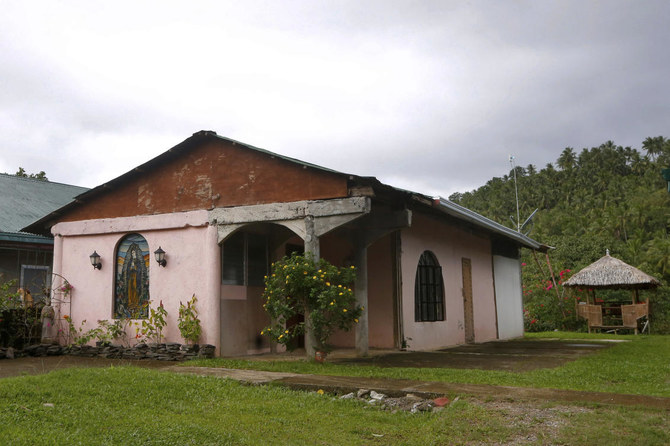
Wave of pro-Palestinian campus protests in US meets forceful response
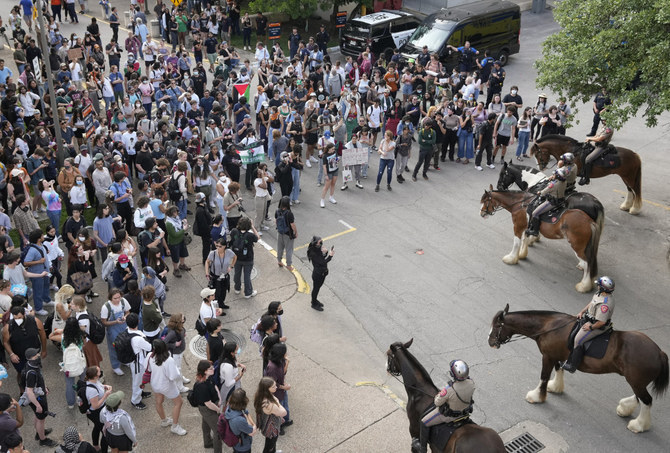
- Fresh clashes between police and students opposed to Israel’s war in Gaza broke out on Thursday
- Questions abound over forceful methods being used to shut down intensifying protests
NEW YORK: Fresh clashes between police and students opposed to Israel’s war in Gaza broke out on Thursday, raising questions about forceful methods being used to shut down protests that have intensified since mass arrests at Columbia University last week.
Over the past two days, law enforcement at the behest of college administrators have deployed Tasers and tear gas against students protesters at Atlanta’s Emory University, activists say, while officers clad in riot gear and mounted on horseback have swept away demonstrations at the University of Texas in Austin.
At Columbia, the epicenter of the US protest movement, university officials are locked in a stalemate with students over the removal of a tent encampment set up two weeks ago as a protest against the Israeli offensive.
The administration, which has already allowed an initial deadline for an agreement with students to lapse, has given protesters until Friday to strike a deal.
Other universities appear determined to prevent similar, long-running demonstrations to take root, opting to work with police to shut them down quickly and in some cases, with force.
Overall, more than 530 arrests have been made in the last week across major US universities in relation to protests over Gaza, according to a Reuters tally. University authorities have said the demonstrations are often unauthorized and called on police to clear them.
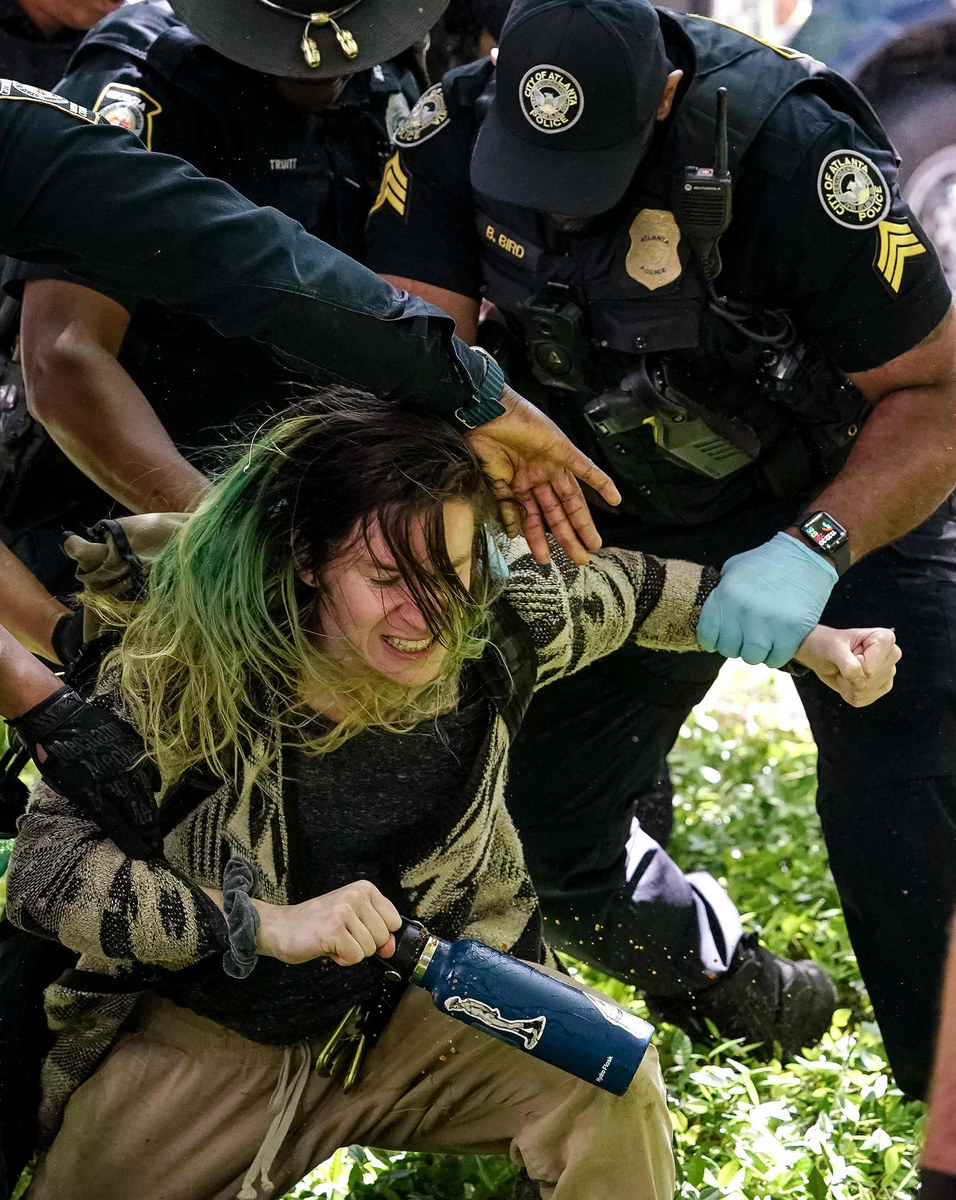
At Emory, police detained at least 15 people on its Atlanta campus, according to local media, after protesters began erecting a tent encampment in an attempt to emulate a symbol of vigilance employed by protesters at Columbia and elsewhere.
The local chapter of the activist group Jewish Voice for Peace said officers used tear gas and Tasers to dispense the demonstration and take some protesters into custody.
Video footage aired on FOX 5 Atlanta showed a melee breaking out between officers and some protesters, with officers using what appeared to be a stun gun to subdue a person and others wrestling other protesters to the ground and leading them away.
“Several dozen protesters trespassed into Emory University’s campus early Thursday morning and set up tents,” the school wrote in response to an emailed request for comment. It described the protesters as “activists attempting to disrupt our university,” but did not comment directly on the reports of violence.
Atlanta police did not immediately respond to inquiries about the number of protesters who were detained or about reports over the use of tear gas and stun guns.
Similar scenarios unfolded on the New Jersey campus of Princeton University where officers swarmed a newly-formed encampment, video footage on social media showed.
Boston police earlier forcibly removed a pro-Palestinian encampment set up by Emerson College, arresting more than 100 people, media accounts and police said. The latest clashes came a day after police in riot gear and on horseback descended on hundreds of student protesters at the University of Texas at Austin and arrested dozens of them.
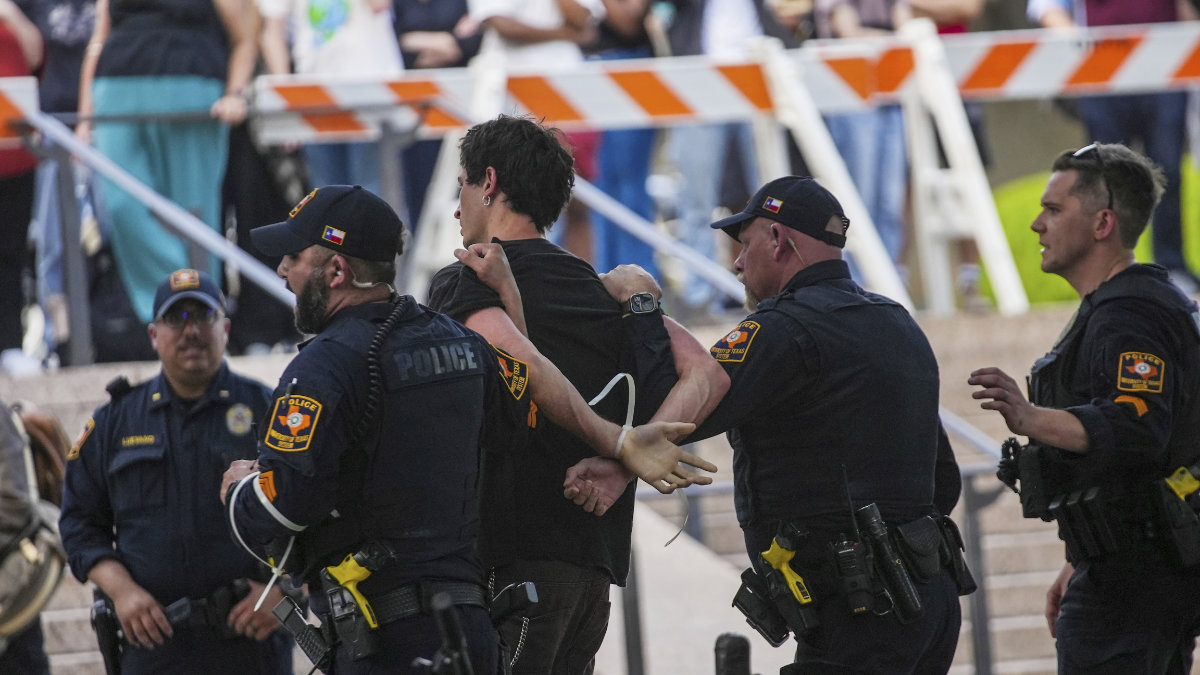
But prosecutors on Thursday dropped charges against most of the 60 people taken into custody, mostly on misdemeanor charges of criminal trespassing and disorderly conduct, and said they would proceed with only 14 of those cases.
In dropping the charges, the Travis County district attorney cited “deficiencies in the probable cause affidavits.”
‘Alarming reports’
Human Rights Watch and the American Civil Liberties Union have condemned the arrest of protesters and urged authorities to respect their free speech rights.
But some Republicans in Congress have accused university administrators of allowing Jewish students to be harassed, putting increasing pressure on schools to tightly control any demonstrations and to block any semi-permanent encampment.
US Education Secretary Miguel Cardona on Thursday said his department was closely monitoring the protests, including what he called “very alarming reports of antisemitism.”
In response, activist groups have strongly denied that the protests are antisemitic. Their aim is to pressure universities from divesting from companies that contribute to the Israeli military actions in Gaza, they say.
Even so, protest leaders have acknowledged that hateful rhetoric has been directed at Jewish students, but insist that people who tried to infiltrate and malign their movement are responsible for any harassment.

Friday deadline at Columbia
At Columbia, officials have given protesters until 4 a.m. on Friday to reach an agreement with the university on dismantling dozens of tents set up on the New York City campus in a protest that started a week ago.
An initial deadline of midnight Tuesday came and went without an agreement, but administrators extended it for 48 hours, citing progress in the talks.
The university already tried to shut the protest down by force. On April 18, Columbia President Minouche Shafik took the unusual move of asking police to enter the campus, drawing the ire of many rights groups, students and faculty.
More than 100 people were arrested and the tents were removed from the main lawn. But within a few days, the encampment was back in place, and the university’s options appeared to narrow.
Protesters have vowed to keep the protests going until their universities agree to disclose and divest any financial holdings that might support the war in Gaza, and grant amnesty to students suspended from school during the demonstrations.
Student protesters have also demanded that the US government rein in Israeli strikes on civilians in Gaza, which have killed more than 34,000 people, according to Palestinian health authorities. Israel is retaliating against an Oct. 7 Hamas attack that killed 1,200 people and led to 253 taken hostage, according to Israeli tallies.
India begins voting in second phase of election as Modi vs Gandhi campaign heats up
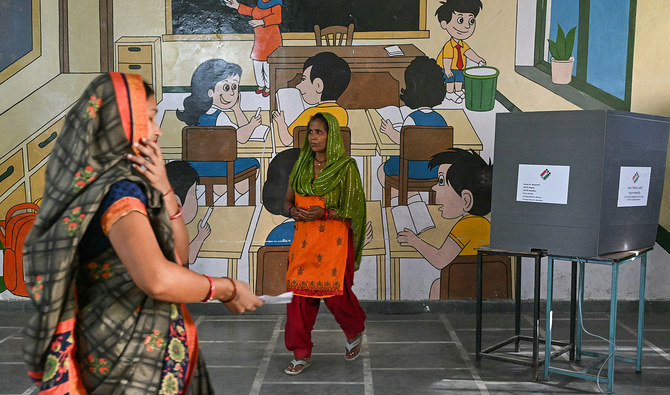
- Almost one billion people eligible to vote in seven-phase general elections that began on April 19 and concludes on June 1
- Modi is seeking record third straight term on the back of economic record, welfare measures, Hindu nationalism
BENGALURU/KOTTAYAM/MATHURA: India began voting on Friday in the second phase of the world’s biggest election, as Prime Minister Narendra Modi and his rivals raise the pitch of the campaign by focusing on hot-button issues such as religious discrimination, affirmative action and taxes.
Almost one billion people are eligible to vote in the seven-phase general elections that began on April 19 and concludes on June 1, with votes set to be counted on June 4.
Modi is seeking a record-equalling third straight term on the back of his economic record, welfare measures, national pride, Hindu nationalism and personal popularity. Surveys suggest he will easily win a comfortable majority.
His challengers have formed an alliance of more than two dozen parties and are promising greater affirmative action, more handouts and an end to what they call Modi’s autocratic rule.
Friday’s polling will be held for 88 of the total 543 seats in the lower house of parliament with 160 million people eligible to vote. It will be spread across 13 states and federal territories in the world’s most populous country.
More than half of those 88 seats are in the southern states of Kerala and Karnataka and the northwestern state of Rajasthan.
The campaign has changed tack since the first phase and become heated as Modi and the main opposition Congress party have faced off on communal issues with Modi accusing Congress of favoring minority Muslims, aiming to dilute affirmative action and planning to impose inheritance tax.
“Congress, which used to make noise in the name of the Constitution, has now been badly exposed for its hidden agenda,” Modi posted on X late on Thursday.
Congress has denied the charges and said Modi is distracting voters from real issues such as unemployment, price rise and rural distress and fears losing.
RAHUL GANDHI IN THE FRAY
“We spoke to you, we heard what was on your mind and drafted a revolutionary manifesto,” Congress leader Rahul Gandhi said in a video message on the eve of the vote. “This has been drafted by the Congress party but it is your voice.”
Gandhi, former Congress president and the face of the party, is among the 1200 candidates in the fray on Friday.
He is seeking re-election from Wayanad in Kerala and faces Annie Raja of the Communist Party of India (CPI) and BJP’s K. Surendran, among others, in the Left Front-ruled state.
In 2019, Gandhi defeated the CPI candidate by more than 400,000 votes, the highest margin in Kerala, although he lost his second seat to BJP in the family bastion of Amethi in north India. India allows a candidate to contest from more than one seat but they can retain only one if they win from more.
Congress slumped to a historic low when it was swept out of power by BJP in 2014 and won its second-lowest number of 52 seats in 2019, with Kerala contributing the highest of 15.
The party is also expected to do better in Karnataka where it won just one of 28 seats in 2019 but gained strength and defeated BJP in state elections last year.
It is still seen to be struggling nationally as bickering within the opposition alliance it leads and graft cases against some leaders has hobbled its challenge to Modi.
The Election Commission and political parties have been worried about voter turnout due to the summer heat and wedding season in some parts of the country with turnout falling to around 65 percent in the first phase from nearly 70 percent in 2019.
The poll panel has increased appeals for voter participation since, asking them to “vote with responsibility and pride.”
Ex-tabloid publisher testifies he scooped up possibly damaging tales to shield his old friend Trump
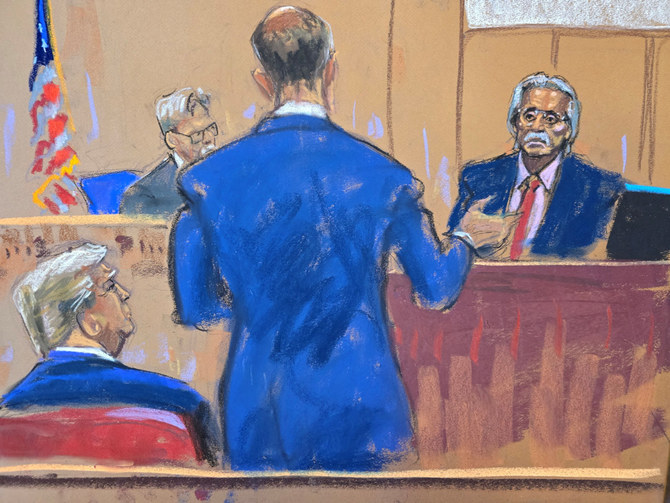
- David Pecker, publisher of the tabloid National Enquirer, has testified that his publication helped buy stories about Trump's extramarital affairs to keep them from getting out
- His testimony was a critical building block for the prosecution’s theory that their partnership was a way to illegally influence the 2016 presidential election
NEW YORK: As Donald Trump was running for president in 2016, his old friend at the National Enquirer was scooping up potentially damaging stories about the candidate and paying out tens of thousands of dollars to keep them from the public eye.
But when it came to the seamy claims by porn performer Stormy Daniels, David Pecker, the tabloid’s longtime publisher, said he put his foot down.
“I am not paying for this story,” he told jurors Thursday at Trump’s hush money trial, recounting his version of a conversation with Trump’s former lawyer Michael Cohen about the catch-and-kill scheme that prosecutors alleged amounted to interference in the race. Pecker was already $180,000 in the hole on other Trump-related stories by the time Daniels came along, at which point, he said, “I didn’t want to be involved in this.”
Pecker’s testimony was a critical building block for the prosecution’s theory that their partnership was a way to illegally influence the 2016 presidential election. The Manhattan district attorney is seeking to elevate the gravity of the history-making first trial of a former American president and the first of four criminal cases against Trump to reach a jury.
Trump’s lawyers also began their cross-examination of Pecker, using the time to question his memory of years-old events and to suggest his account had evolved over time.
But the hush money trial was just one of the consequential legal matters facing the Republican presidential candidate on Thursday.
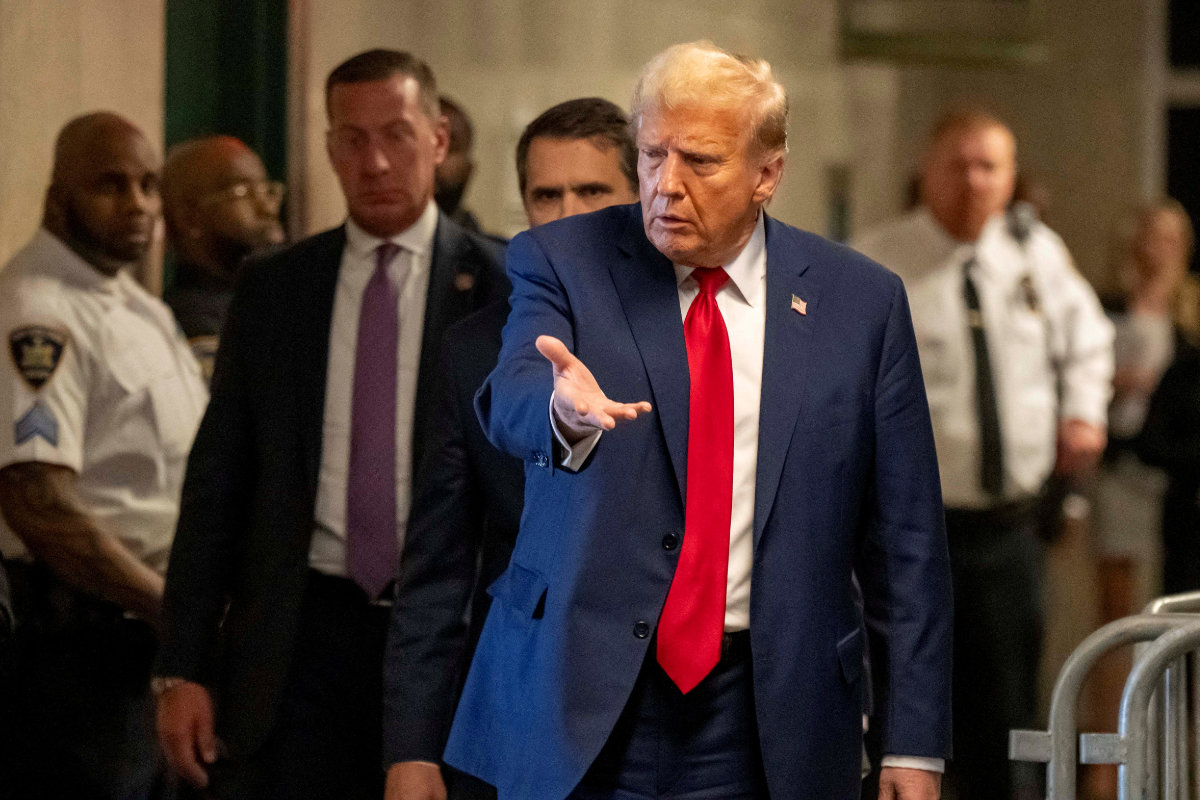
The US Supreme Court also heard arguments over whether Trump should be immune from criminal prosecution while he was the president, stemming from federal charges over his efforts to reverse his 2020 election loss to Joe Biden. The high court justices appeared likely to reject his claims of absolute immunity, though it seemed very possible that trial could be delayed beyond November’s election.
Trump’s many legal problems collided this week. The hush money case includes a looming decision on whether he violated a gag order and should be held in contempt. His former lawyers and associates were indicted in a 2020 election-related scheme in Arizona. And a New York judge rejected a request for a new trial in a defamation case that found Trump liable for $83.3 million in damages.
But the former president has a long history of emerging unscathed from sticky situations — if not becoming even more popular.
The Supreme Court’s decision will have lasting implications for future presidents, because the justices were seeking to answer the never-before-asked question of whether and to what extent does a former president enjoy immunity from prosecution for conduct during his time in office. But it may not impact the New York City case, which hinges mostly on Trump’s conduct as a presidential candidate in 2016 — not as a president.
Trump had asked to skip his New York criminal proceedings for the day so he could sit in on the Supreme Court’s special session, but that request was denied by Judge Juan M. Merchan, who is overseeing Trump’s trial on 34 felony counts of falsifying business records in connection with the hush money payments, which involved buying the rights to someone’s story but never publishing it.
“I think the Supreme Court has a very important argument before it today,” Trump said outside the courtroom. “I should be there.”
Instead, he sat at the defense table in a Manhattan courtroom with his lawyers, listening intently to Pecker testify how he and his publication parlayed rumor-mongering into splashy stories that smeared Trump’s opponents and, just as crucially, leveraged his connections to suppress unflattering coverage.
Trump has maintained he is not guilty of any of the charges, and says the stories that were bought and squelched were false.
“There is no case here. This is just a political witch hunt,” he said before court in brief comments to reporters.
As Pecker testified in a calm, cooperative tone about risque tales and secret dealings, the atmosphere in the utilitarian 1940s courtroom was one of quiet attentiveness. Two Secret Service agents were stationed in the first row of the courtroom gallery directly behind Trump. Ten court officers stood around the room. Jurors intently listened, and some took notes.
Pecker recalled that the publication bought a sordid tale from a New York City doorman and purchased accusations of an extramarital affair with former Playboy model Karen McDougal to prevent the claims from getting out. There was some talk of reimbursement from Trump’s orbit, but Pecker was ultimately never paid.
The breaking point came with Daniels, who was eventually paid by Cohen to keep quiet over her claim of a 2006 sexual encounter with Trump. The ex-president denies it happened.
Pecker recalled to the jury that he was dining with his wife the night after the public learned of the infamous 2005 “Access Hollywood” tape in which Trump discussed grabbing women sexually without permission, when then-editor Dylan Howard called with an urgent matter.
Howard said he heard from Daniels’ representatives that she was trying to sell her story and that the tabloid could acquire it for $120,000, Pecker told jurors. Pecker was tapped out; he told Cohen as much.
At the same time, Pecker advised that someone — just not him — should do something to prevent the story from going public.
“I said to Michael, ‘My suggestion to you is that you should buy the story, and you should take it off the market because if you don’t and it gets out, I believe the boss will be very angry with you.’”
Cohen followed his advice.
Pecker testified that Trump later invited him to a White House dinner in July 2017 to thank him for helping the campaign. The ex-publisher said Trump encouraged him to bring anyone he wanted, recounting that the then-president told him, “It’s your dinner.”
Pecker said that he and Howard, as well as some of his other business associates, posed for photos with Trump in the Oval Office. Pecker said others at the dinner included Trump son-in-law Jared Kushner and press adviser Sean Spicer.
At one point during the evening, Pecker said Trump asked him for an update on Karen McDougal.
“How’s Karen doing?” he recalled Trump saying as they walked past the Rose Garden from the Oval Office to the dining room.
“I said she’s doing well, she’s quiet, everything’s going good,” Pecker testified.
But months later, in March 2018, the president became furious when McDougal gave an interview to CNN’s Anderson Cooper, Pecker testified.
“I thought you had and we had an agreement with Karen McDougal that she can’t give any interviews or be on any TV channels,” Trump told Pecker by phone, the former National Enquirer publisher said.
He said he explained to the then-president that the agreement had been changed to allow her to speak to the press after a November 2016 Wall Street Journal article about the tabloid’s $150,000 payout to McDougal.
“Mr. Trump got very aggravated when he heard that I amended it, and he couldn’t understand why,” Pecker told jurors.
Later, Trump defense attorney Emil Bove opened his cross-examination by grilling Pecker on his recollection of specific dates and meanings. He appeared to be laying further groundwork for the defense’s argument that any dealings Trump had with the National Enquirer publisher were intended to protect himself, his reputation and his family — not his campaign.
In other developments, prosecutors argued Trump again violated a gag order, all while waiting to hear whether he would be held in contempt on other suspected violations. Merchan has barred the GOP leader from making public statements about witnesses, jurors and others connected to the case. He set a hearing for next Thursday on the new claims.
Trump was dismissive about the looming decision. When asked by reporters if he would pay fines if ordered, he replied, “Oh, I have no idea.” He then said, “They’ve taken my constitutional right away with a gag order.”
A conviction by the jury would not preclude Trump from becoming president again, but because it is a state case, he would not be able to pardon himself if found guilty. The charge is punishable by up to four years in prison — though it’s not clear if the judge would seek to put him behind bars.
Xi tells Blinken US, China must be ‘partners, not rivals’: state media
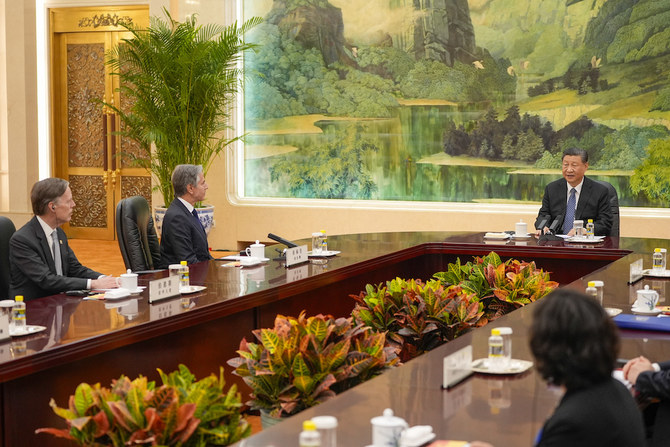
BEIJING: Chinese President Xi Jinping on Friday told top US diplomat Antony Blinken that the world’s two biggest economies should be “partners, not rivals,” adding that there were a “number of issues” to be resolved in their relations.
“The two countries should be partners, not rivals,” Xi said, according to state broadcaster CCTV, adding: “There are still a number of issues that need to be resolved, and there is still room for further efforts.”
China urged Blinken to address rising disagreements or risk a “downward spiral” between the two powers as talks opened in Beijing.
Blinken, paying his second visit to the rival country in less than a year, voiced hope for progress but said he would directly raise areas of difference, which are expected to include Russia, Taiwan and trade.
Chinese Foreign Minister Wang Yi, receiving Blinken at the Diaoyutai state guesthouse in the capital’s ancient gardens, said relations between the world’s two largest economies were “beginning to stabilize” after leaders Joe Biden and Xi Jinping met at a November summit.
“But at the same time, the negative factors in the relationship are still increasing and building,” Wang said.
“The relationship is facing all kinds of disruptions. China’s legitimate development rights have been unreasonably suppressed and our core interests are facing challenges,” he said.
“Should China and the United States keep in the right direction of moving forward with stability, or return to a downward spiral?
“This is a major question before our two countries and tests our sincerity and ability.”
Blinken’s aides previously said he would address a range of concerns including China’s support for Russia, which has rapidly rebuilt its military base two years into its invasion of Ukraine.
As he opened the meeting with Wang, Blinken said he would be “very clear, very direct,” but added: “I hope we make some progress on the issues our presidents agreed” on.
The two countries should be as “clear as possible about the areas where we have differences — at the very least to avoid misunderstandings, to avoid miscalculations,” Blinken said.
“That really is a shared responsibility that we have not only for our own people, but for people around the world.”
France threatens new sanctions against West Bank settlers
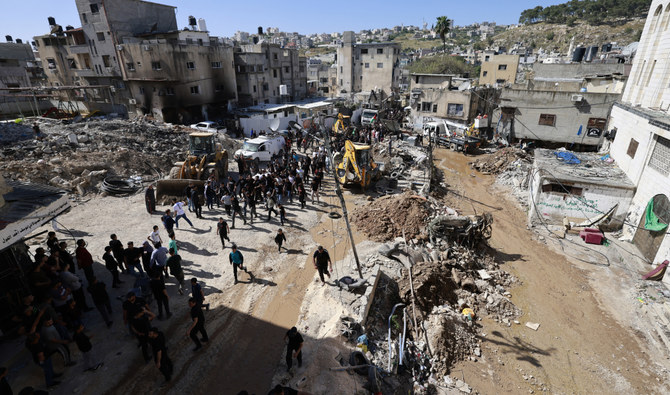
- In February, 28 ‘extremist Israeli settlers’ were banned from entering French territory
- At least 488 Palestinians have been killed by Israeli troops or settlers in the West Bank since October 7, according to Palestinian officials
PARIS: France is considering extending sanctions on Israeli settlers behind violence against Palestinian civilians in the occupied West Bank, President Emmanuel Macron’s office said he spoke with Jordan’s King Abdullah II.
The two leaders “firmly condemned recent Israeli announcements about settlements” in the West Bank, “which are contrary to international law,” Macron’s office said in a statement.
Tensions have mounted in the occupied territories since the Hamas October 7 attack on Israel that set off the Gaza war. At least 488 Palestinians have been killed by Israeli troops or settlers in the West Bank since October 7, according to Palestinian officials.
In February, 28 “extremist Israeli settlers” were banned from entering French territory. Last week the European Union imposed sanctions on four Israeli settlers and two settler organizations for violence against Palestinians in the West Bank and Jerusalem.
Since the start of the year, Israeli authorities have declared nearly 1,100 hectares (2,720 acres) of the West Bank to be “state land” — twice as much as in the previous record year in 1999, according to the settlement watchdog Peace Now.
The status gives the government full control over how the land is used, inevitably leading it to being declared off-limits to Palestinians.
Some 490,000 Israeli settlers now live in the West Bank alongside three million Palestinians.
Macron and King Abdullah also spoke about the “catastrophic humanitarian situation in Gaza” and expressed “great concern about the perspective of an Israeli offensive on Rafah, where more than 1.5 million people are seeking refuge, and reiterated their opposition to such an operation,” the statement said.
“The two also insisted on the necessity of an immediate and durable ceasefire to allow massive deliveries of urgent aid and the protection of civilian populations,” it added.
Macron also “repeated that the liberation of hostages held by Hamas was an absolute priority for France.”




